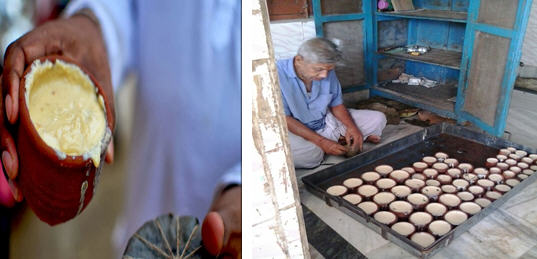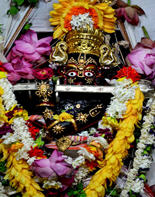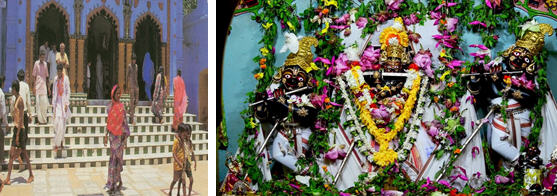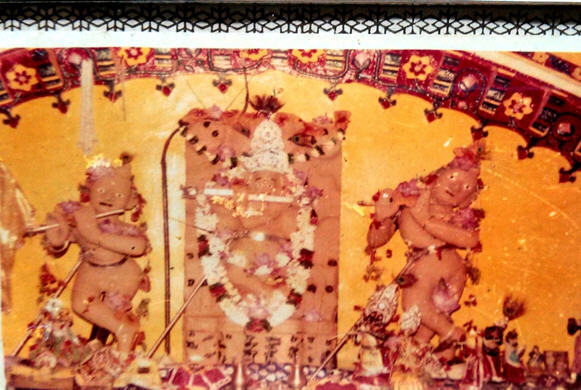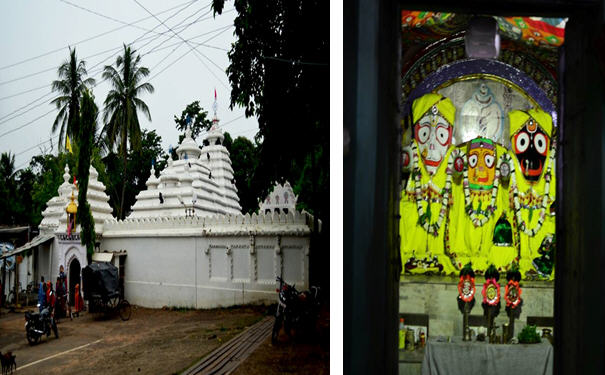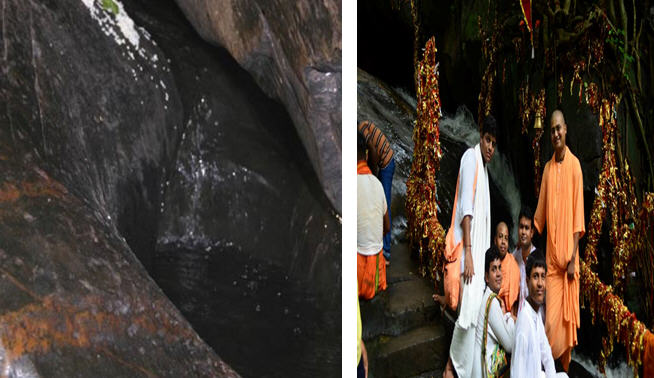The pujari (priest) told me, "You must come and see the dressing of the Deities at 6:30 in the morning." So we went. To be allowed to see the dressing of a Deity is rare, but here everyone can come see. Gopinatha appears carved from a piece of stone, like a bas-relief, except that most of His form is visible. (See "How the Deity Came to Remuna, p. 27.) On the stone are other figures, said to be carved by Lord Krsna in His incarnation as Lord Ramacandra. The pujari showed us these figures.
We also found out why Gopinatha's flute looks rectangular, as you can see in His photo, rather than cylindrical: the flute you see covers the original flute, which is rectangular and is part of the Deity.
As the dressing began, only Maha-Visnu Dasa and I were there to watch. Gradually a few more people came, everyone looking intensely at the beauty of the Deities. We sat chanting on our beads, drinking through our eyes the beauty of Govinda, Gopinatha, and Madana-mohana. (The Deities of Govinda and Madana-mohana were brought here from Vrndavana about 1938 by a devotee named Caitanya Dasa Babaji.)
The pujari quickly and expertly dressed the Deities using simple cloth, which he twisted and turned to make an attractive outfit.
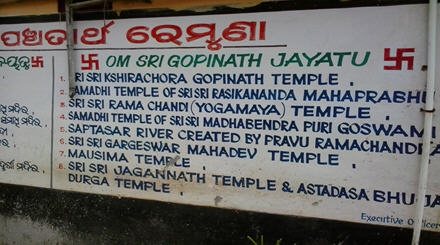
Remuna's Holy Sites I first came to Remuna in 1978. The place now is more developed. Nothing grand, but there are a few shops, and many more people come to see the Deity. Many come to arrange for sons and daughters to be married in the temple. Pilgrims come in a steady flow throughout the day, but no big crowds like the ones you'll find at Puri, Tirupati, or Nathadwar. Probably a few hundred pilgrims a day visit here, a thousand or so on Sundays. We are here in the summer, when there are not so many visitors. In the winter, when the weather is cool, more people come, mostly from Orissa and Bengal. Many people who visit belong to various Gaudiya Vaisnava sects, groups of followers of Lord Caitanya. Several Gaudiya families have settled here.
Previously Remuna was directly on the route between Bengal and Puri. Now it's slightly off the route. The main rail line goes through Baleshwar, twelve kilometers east. The original route still exists and is known as Gaura-danda, "the path touched by the holy feet of Lord Caitanya."
The Gopinatha temple stands in an area by itself in the fields, about half a kilometer from the village of Remuna. At the main entrance to the temple, a bakul tree with huge branches marks a spot said to be the site of the first temple, built by King Narasimhadeva.
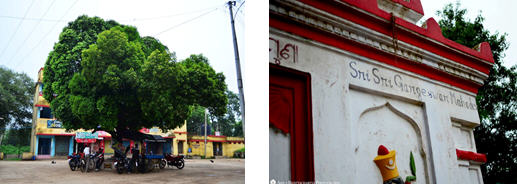
About two hundred meters from the present temple, near the temples of Ramacandi and Gargasvara, there used to be a village market. The local people say it belonged to a cowherd village where every day the villagers gave sixty liters of milk to make Gopinatha a spiced condensed milk called amrta-keli. The market, it is said, is where Madhavendra Puri stayed when he came to Remuna. (See "How Gopinatha Got the Name Ksira-cora," p. 32.) Madhavendra Puri's sitting place and wooden shoes are worshiped at a small temple at the spot. The temple is the samadhi (tomb) of Madhavendra Puri.
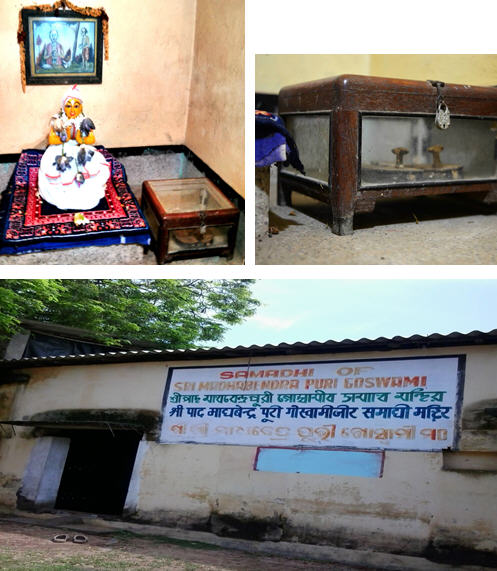
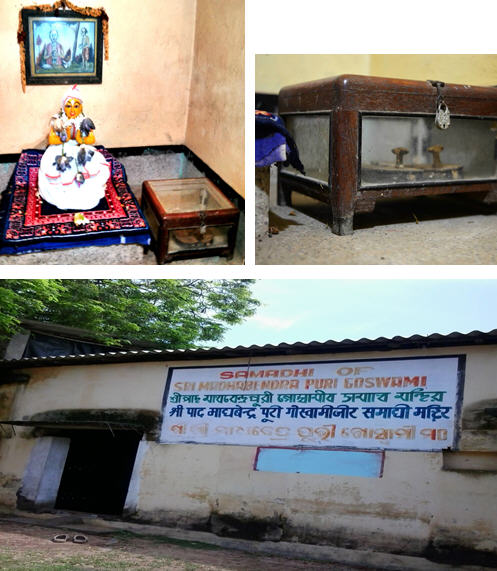
In two places at the Gopinatha temple, pilgrims worship the footprints of Caitanya Mahaprabhu. The footprints are modeled after the ones in the Jagannatha temple in Puri, where Caitanya Mahaprabhu would stand next to the Garuda-stambha, the pillar holding Garuda, the eagle carrier of Lord Visnu.
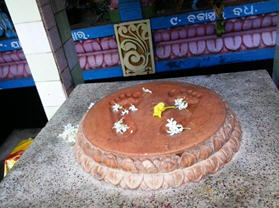
It is said that Lord Caitanya felt such intense ecstasy upon seeing the Jagannatha Deity that His feet melted impressions into the stone floor. A little shop at the Gopinatha temple sells books in Oriya, Bengali, and English telling about the glories of the temple. The shop sells photos of Gopinatha (for visitors to photograph the Deity is prohibited). The shop also sells sweets to offer the Deity. After being offered, the sweets are given back to the person who bought them, a common system in India.
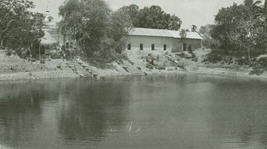
Just outside the entrance to the temple is a small manmade pond. It has steps going down to it so one can reach it to bathe. Another pond, a very old one, about a hundred meters from the temple, is where devotees from Bengal would bathe on the way to see Lord Caitanya in Puri. Caitanya Mahaprabhu, Nityananda Prabhu, Madhavendra Puri so many great souls must have bathed here. And now we are so fortunate to get that chance. Although the pond has become the local place where people come to wash their clothes, the spiritual benefit of bathing there remains.
About a ten-minute walk from the temple of Ksira-cora Gopinatha is a branch of the Gaudiya Math, the mission of Srila Bhaktisiddhanta Sarasvati Thakura, Prabhupada's spiritual master. When he came here just a few years before he left this world, he wanted to start a branch of his mission here but did not accomplish that desire. Shortly after he left this world, however, someone donated for the Gaudiya Math in Remuna a 300-year-old Jagannatha temple. Besides the Jagannatha deities, the temple is now the home of Radha-Krsna Deities originally installed by Srila Bhaktisiddhanta Sarasvati in Mymensingh, in what is now Bangladesh. The Radha-Krsna Deities were brought here when Bengal was partitioned.
